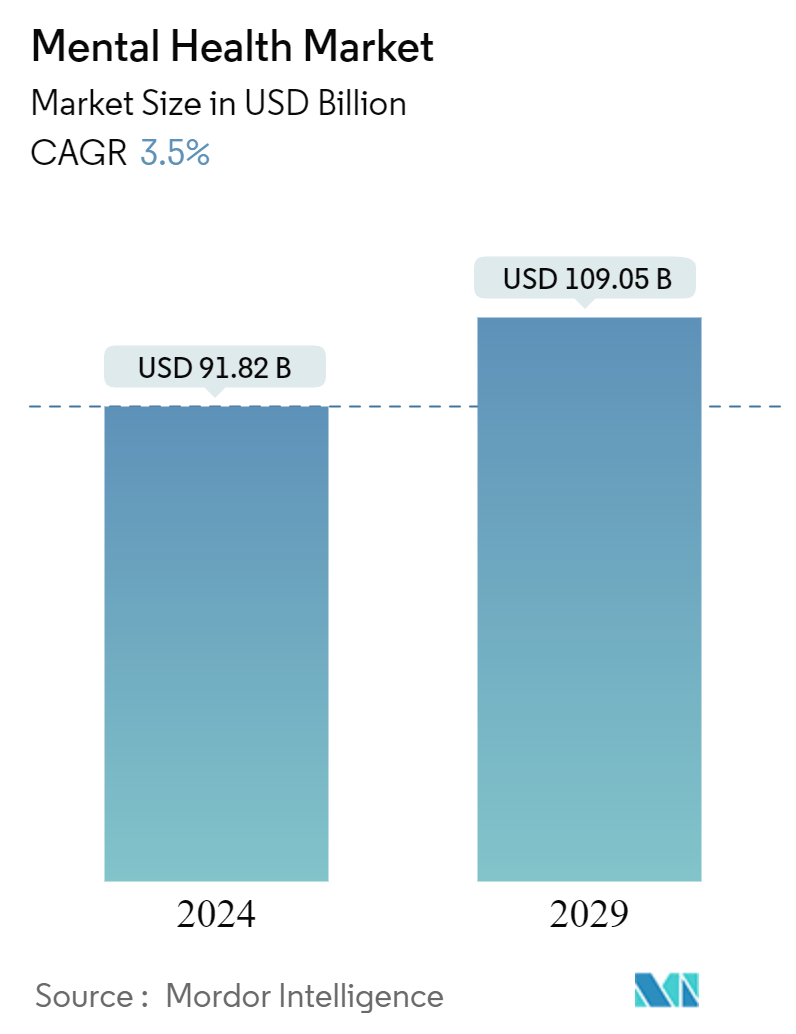Market Size of Mental Health Industry

| Study Period | 2019 - 2029 |
| Market Size (2024) | USD 91.82 Billion |
| Market Size (2029) | USD 109.05 Billion |
| CAGR (2024 - 2029) | 3.50 % |
| Fastest Growing Market | Asia Pacific |
| Largest Market | North America |
Major Players
*Disclaimer: Major Players sorted in no particular order |
Mental Health Market Analysis
The Mental Health Market size is estimated at USD 91.82 billion in 2024, and is expected to reach USD 109.05 billion by 2029, growing at a CAGR of 3.5% during the forecast period (2024-2029).
Factors such as the rise in the prevalence of chronic diseases, the increase in the geriatric population, and new initiatives to improve mental health awareness are expected to contribute to the market growth.
The primary factors that drive the market growth are the increasing prevalence of mental disorders along with the rising geriatric population and rising mental health awareness through campaigns. Mental illnesses are a wide range of conditions, each manifesting with varying severity levels ranging from mild to moderate to severe. For instance, according to the report published by the World Health Organization in June 2022, 1 in 8 people worldwide experience a mental disorder that involves significant disturbances in thinking, emotional regulation, or behavior.
Similarly, as per the report published by the Mental Health Foundation, in 2022-2023, a higher percentage of women (37.1%) than men (29.9%) in the United Kingdom reported experiencing high levels of anxiety. This shows the high burden of mental disorders globally and regionally, which is expected to have a significant impact on the market.
The new campaigns aim to raise public awareness of mental health and promote access to mental health services, which are expected to impact market growth significantly. For instance, in May 2023, The National Alliance on Mental Illness (NAMI) launched MoreThanEnough, an empowering campaign for 2023 Mental Health Awareness Month. This campaign aims to address urgent needs and create a sense of belonging for people with ongoing mental health crises, which makes them have proper treatment using mental health services and likely propel the market growth during the forecast period.
Therefore, with the rise in chronic diseases' prevalence, an increasing geriatric population, and new government initiatives aimed at improving mental health awareness, the market growth is expected to be hindered by the rising costs of mental health services during the forecast period.
Mental Health Industry Segmentation
As per the scope of the report, mental health includes emotional, psychological, and social well-being. An altered mental health condition is considered a mental illness, which includes depression, anxiety disorders, schizophrenia, eating disorders, and addictive behaviors.
The mental health market is segmented by mental health disorder, services, age group, and geography. By mental health disorder, the market is segmented into depression, bipolar disorder, schizophrenia, anxiety, post-traumatic stress disorder (PTSD), and other mental disorders. By services, the market is segmented into inpatient treatment services, residential treatment services, outpatient treatment services, emergency mental health services, and other mental health services. By age group, the market is segmented into pediatric, adult, and geriatric. By geography, the market is segmented into North America, Europe, Asia-Pacific, the Middle East and Africa, and South America. For each segment, the market size is provided in terms of USD value.
| By Mental Health Disorder | |
| Depression | |
| Bipolar Disorder | |
| Schizophrenia | |
| Anxiety | |
| Post-traumatic Stress Disorder (PTSD) | |
| Other Mental Disorders |
| By Services | |
| Inpatient Treatment Services | |
| Residential Treatment Services | |
| Outpatient Treatment Services | |
| Emergency Mental Health Services | |
| Other Mental Health Services |
| By Age Group | |
| Pediatric | |
| Adult | |
| Geriatric |
| Geography | ||||||||
| ||||||||
| ||||||||
| ||||||||
| ||||||||
|
Mental Health Market Size Summary
The mental health market is poised for significant growth, driven by an increasing prevalence of mental disorders and a rising geriatric population. Awareness campaigns and initiatives aimed at improving mental health understanding and access to services are further propelling market expansion. The market is characterized by a diverse range of mental health conditions, from mild to severe, with depression being a prominent concern globally. The demand for effective psychological treatments and advanced services, such as telemedicine, is on the rise, contributing to the market's upward trajectory. Despite the positive growth outlook, the market faces challenges, including the rising costs of mental health services, which could potentially hinder progress.
In North America, the mental health market is expected to capture a significant share due to the increasing incidence of mental disorders and supportive government initiatives. The establishment of new mental healthcare centers and funding for mental health services are key factors driving growth in the region. The market is fragmented, with numerous players expanding their services globally, which helps sustain growth. Notable companies in the sector include Acadia Healthcare, Vita Health Group, and Behavioral Health Services, among others. Recent developments, such as the opening of new psychiatric hospitals and the introduction of neuromodulation therapies, underscore the ongoing efforts to address the growing demand for mental healthcare services.
Mental Health Market Size - Table of Contents
-
1. MARKET DYNAMICS
-
1.1 Market Overview
-
1.2 Market Drivers
-
1.2.1 Increasing Prevalence of Mental Disorders Along With Rising Geriatric Population
-
1.2.2 Rising Mental Health Awareness Through Campaigns
-
-
1.3 Market Restraints
-
1.3.1 Rising Costs of Mental Health Services
-
-
1.4 Porter's Five Forces Analysis
-
1.4.1 Threat of New Entrants
-
1.4.2 Bargaining Power of Buyers/Consumers
-
1.4.3 Bargaining Power of Suppliers
-
1.4.4 Threat of Substitute Products
-
1.4.5 Intensity of Competitive Rivalry
-
-
-
2. MARKET SEGMENTATION (Market Size by Value - USD)
-
2.1 By Mental Health Disorder
-
2.1.1 Depression
-
2.1.2 Bipolar Disorder
-
2.1.3 Schizophrenia
-
2.1.4 Anxiety
-
2.1.5 Post-traumatic Stress Disorder (PTSD)
-
2.1.6 Other Mental Disorders
-
-
2.2 By Services
-
2.2.1 Inpatient Treatment Services
-
2.2.2 Residential Treatment Services
-
2.2.3 Outpatient Treatment Services
-
2.2.4 Emergency Mental Health Services
-
2.2.5 Other Mental Health Services
-
-
2.3 By Age Group
-
2.3.1 Pediatric
-
2.3.2 Adult
-
2.3.3 Geriatric
-
-
2.4 Geography
-
2.4.1 North America
-
2.4.1.1 United States
-
2.4.1.2 Canada
-
2.4.1.3 Mexico
-
-
2.4.2 Europe
-
2.4.2.1 Germany
-
2.4.2.2 United Kingdom
-
2.4.2.3 France
-
2.4.2.4 Italy
-
2.4.2.5 Spain
-
2.4.2.6 Rest of Europe
-
-
2.4.3 Asia-Pacific
-
2.4.3.1 China
-
2.4.3.2 Japan
-
2.4.3.3 India
-
2.4.3.4 Australia
-
2.4.3.5 South Korea
-
2.4.3.6 Rest of Asia-Pacific
-
-
2.4.4 Middle East and Africa
-
2.4.4.1 GCC
-
2.4.4.2 South Africa
-
2.4.4.3 Rest of Middle East and Africa
-
-
2.4.5 South America
-
2.4.5.1 Brazil
-
2.4.5.2 Argentina
-
2.4.5.3 Rest of South America
-
-
-
Mental Health Market Size FAQs
How big is the Mental Health Market?
The Mental Health Market size is expected to reach USD 91.82 billion in 2024 and grow at a CAGR of 3.5% to reach USD 109.05 billion by 2029.
What is the current Mental Health Market size?
In 2024, the Mental Health Market size is expected to reach USD 91.82 billion.

